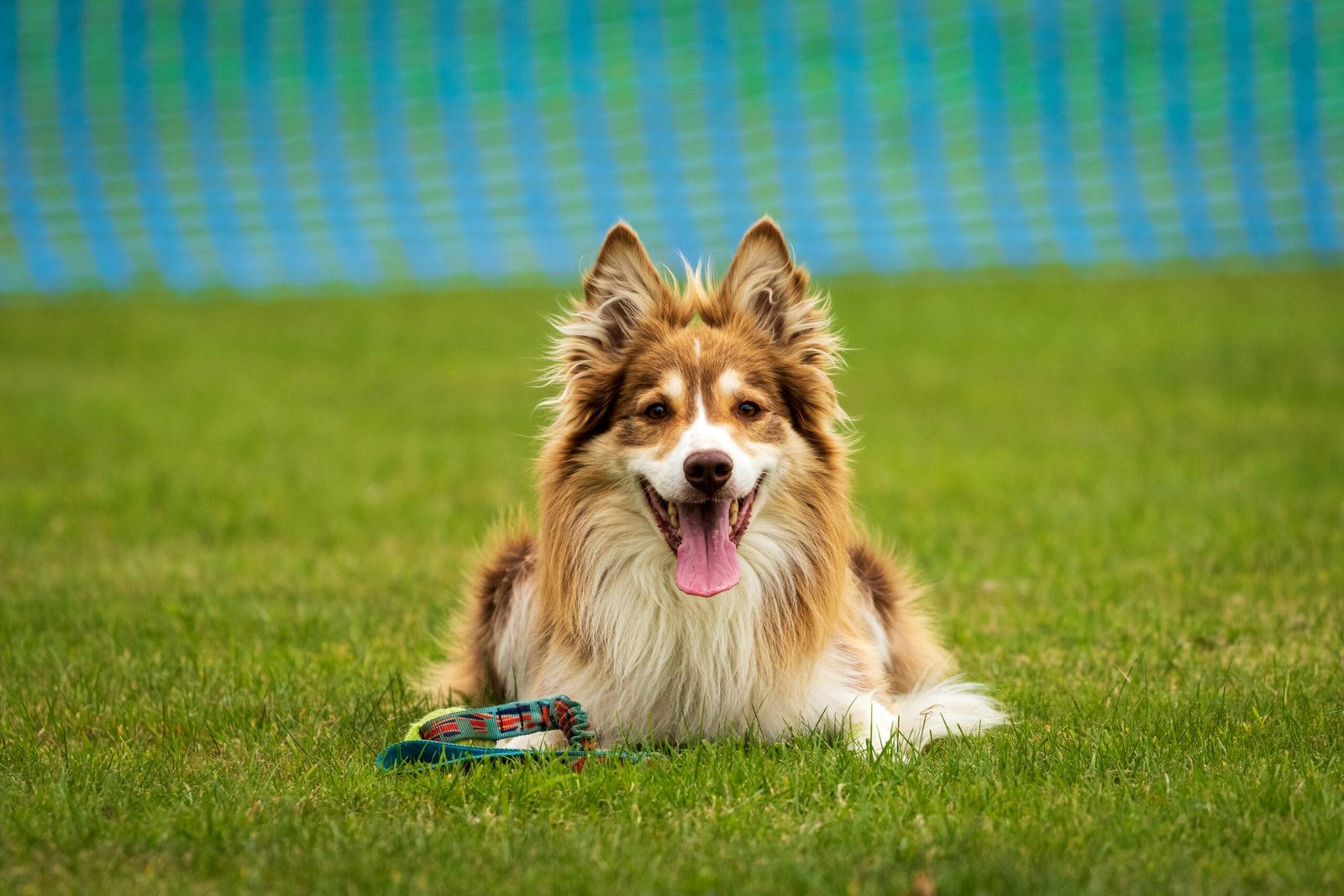If you’re looking to train your Sheepadoodle, remember a few basic guidelines, regardless of your training approach. Though advice and opinions are abundant on Sheepadoodle training available online, it’s important to remember that each dog is unique. As such, I cannot give you a step-by-step guide to training your Sheepadoodle with absolute certainty. Here’s a guide of well-researched pieces of training to improve your Sheepadoodle behavior.
Sheepadoodle Puppy Training At Home (First 30 Days)
During the first thirty days of their lives, Sheepadoodle puppies are not considered puppies yet. They are called neonates and are still underdeveloped, being born blind. It is unlikely that readers of this article have neonates in their possession, as they need to be with their mothers for breastfeeding and socialization with their litter. Typically, puppies are given to their new owners around eight weeks old. However, breeders can prepare the neonates for their future lives by socializing them with over 100 people, starting chew toy and potty training, and teaching basic commands such as sit, down, and rollover.
Unfortunately, such preparation by breeders is rare, so new owners usually have to do all these things when they adopt the dog.

Sheepadoodle Puppyhood – The First Week At Home
When you bring your Sheepadoodle puppy home, training should begin immediately. During the first week, it’s important to focus on house training and teaching basic commands such as “sit,” “stay,” and “lie down.” Even though your puppy isn’t vaccinated yet and shouldn’t be taken outside, you should still start leash training and socialization. Invite friends and strangers to your home and reward your puppy for good behavior, such as sitting or lying down. Allow them to pet your puppy and gently touch its ears to prepare it for the vet’s handling during vaccination visits. It’s necessary to train your puppy with the leash on to help you control it and get used to wearing the leash for future walks.
Sheepadoodle Puppy Preschool (The Second Week Until Three Months)
During the critical period of socialization, which I have named Sheepadoodle puppy preschool, puppies need to interact with many other dogs and humans. Your Sheepadoodle puppy should be exposed to people of all ages, wearing different types of clothing, and with different physical characteristics. It will help your puppy understand that humans pose no threat to them.
Training your puppy in bite inhibition during this time is also crucial. Failure to do so can result in serious harm when your dog becomes an adult. One effective way to train your puppy to control their biting is to encourage them to chew on chew toys.
It is natural for puppies to nibble on their hand between eight weeks and three months of age. If they accidentally hurt you, respond with an “ow” and a pout, which will help them understand the strength of their bite. This training will prevent them from causing unintentional harm when they become adult dogs.

Sheepadoodle Puppy Kindergarten (Three Months To Six Months)
Exposing your Sheepadoodle puppy to the outside world at three to six months old is essential. It means extensive leash training to help your Sheepadoodle pup get used to the sights and sounds of the world around them. During this time, pay attention to what makes your dog nervous, such as cars, people on bicycles, or men with suspenders. Then, train your dog to like these things by providing them treats or praise whenever they encounter these stimuli. It will help your dog associate positive feelings with these situations and reduce nervousness.
Towards the end of this period, your dog’s hunting instincts may kick in, causing them to notice squirrels and potentially even hump other dogs if they are male. Your well-trained puppy may also display signs of rebellion and disobedience but don’t worry. It is natural. Continue with the training and reinforce positive behaviors.

Sheepadoodle Puppy High School (Six Months To Eighteen Months)
During the six to eighteen months, your Sheepadoodle puppy goes through adolescence. It can lead to awkwardness and difficulties, similar to teenagers. Male dogs may tend to initiate fights at the dog park. Training may also regress during this time, and your dog might make mistakes inside the house if you’re not careful.
It is crucial to continue socializing with your dog during this period. Please take it to the dog park regularly, and continue with a leash and house training. You could also try some fun activities like agility training.
Sweet Adulthood
As your Sheepadoodle puppy grows up after high school, they reach a certain point where they become more self-confident and self-contained. Fortunately, Sheepadoodles tend to stick around and don’t leave for college like human children so you won’t be an empty nester. However, there is a better time to slack off on training. It’s vital to continue rewarding good behavior and addressing issues before they become ingrained habits. By doing so, you’ll have a well-behaved Sheepadoodle who will make their twilight years the best time you’ll spend with them. Remember, training is a continuous process throughout their adulthood.
Sheepadoodle Training
Challenge Their Mind
Sheepadoodles need mental stimulation to prevent behavioral issues. Find brain-training games to challenge them and improve their mental wellness alongside proper nutrition and exercise.
Pros:
- Stimulation: Engaging your Sheepadoodle mentally can keep them stimulated and reduce the chances of boredom. This mental stimulation ensures that their intelligence is harnessed in productive ways.
- Behavior Improvement: A mentally challenged Sheepadoodle is less likely to indulge in undesirable behavior such as aggression, biting, and destruction. The mental exercises redirect their energy to more positive outlets.
- Stronger Bond: By actively engaging with your dog in brain games and challenges, you reinforce your bond with them. It’s a way of spending quality time together that’s rewarding for both of you.
- Improved Quality of Life: Mentally active Dogs have a higher quality of life. They remain alert, playful, and generally happier than dogs without such stimulation.
- Adaptability: Challenging a dog’s brain can make them more adaptable. They become better at problem-solving and can cope more effectively with their challenges.
- Increased Longevity: Evidence suggests that mentally active dogs tend to live longer and healthier lives. Just as humans benefit from keeping their brains engaged as they age, the same holds for dogs.
Cons:
- Overstimulation: Just as physical over-exercise can be harmful, over-challenging a dog mentally can lead to stress and anxiety. It’s essential to find a balance and not overdo it.
- Frustration: Some challenges may be too complex for your Sheepadoodle, leading to frustration. If a task is too difficult, the dog might become disinterested in such activities.
- Time-Consuming: Engaging your dog in mental exercises requires commitment from the owner. Only some people have the time or patience to introduce regular brain games into their dog’s routine.
- Potential for Negative Reinforcement: Challenging exercises can lead to negative reinforcement if not done correctly. For example, if a dog fails to complete a task and is punished or not rewarded, it may associate the activity with negativity.
- Expense: Investing in toys, games, and training programs designed to stimulate your dog mentally can become pricey. While many exercises can be done without special tools, some more advanced challenges may require an investment.
- Unintended Consequences: If a Sheepadoodle becomes too adept at solving particular challenges, it might unintentionally apply these skills. For instance, figuring out how to open doors, get into containers, or do other mischief.
One command at a time
It is advisable to teach your Sheepadoodle basic commands one at a time and wait until they have mastered each one before moving on to the next. Attempting to teach multiple orders simultaneously may lead to confusion and discouragement for your Sheepadoodle. Your Sheepadoodle will gain the self-confidence necessary to learn additional commands by fully getting one control.
Pros:
- Clarity: Teaching one command at a time ensures that your Sheepadoodle understands your expectations. This singular focus eliminates any ambiguity in training.
- Practical Learning: When isolated, it’s easier for the dog to associate a specific action with a particular command. This method ensures that the dog effectively learns and internalizes each command.
- Builds Confidence: Mastery of one command before moving to the next boosts the Sheepadoodle’s self-esteem. Each success is a building block, reinforcing the dog’s belief in its ability to learn.
- Allows for Reinforcement: Teaching one command at a time provides ample opportunity to reinforce the behavior with rewards, ensuring the behavior sticks.
- Better Assessment: This method allows for a more straightforward assessment of your dog’s progress. You can see if they’ve grasped one command before proceeding.
- Lesser Confusion: It minimizes the chance of the Sheepadoodle getting commands mixed up, as there’s no overlap in training sessions.
- Individualized Training: Not all commands are of equal difficulty. Teaching one at a time ensures that each order gets the attention and repetition it requires based on its complexity.
Cons:
- Time-Consuming: Training one command at a time can be a lengthier process as you wait for mastery of each order before moving on.
- Potential for Monotony: Focusing on a single command might become repetitive for both the dog and the trainer, which could reduce enthusiasm over time.
- Delayed Introduction of Essential Commands: If a particular command is vital for safety, such as “come” or “stay,” waiting to teach it could pose risks, especially if it’s queued behind other less crucial commands.
- Overemphasis: There’s a chance of overemphasizing one command to the point where a Sheepadoodle might start offering that behavior even when not asked because it’s so ingrained.
- Reduced Adaptability: In real-life scenarios, dogs must often switch between commands rapidly. If trained only one at a time without integration, the Sheepadoodle might need help to adapt to situations requiring quick shifts between commands.
Step by Step Crate Training a Sheepadoodle
- Get a crate for your Sheepadoodle. Make sure it’s the right size for them to move around comfortably, but not too big. They should feel cozy inside.
- Add comfortable bedding and familiar toys to make the crate inviting for your Sheepadoodle. Please place it in a busy area to alleviate separation anxiety. Remember, the crate should be a place of comfort, not punishment.
- Encourage your Sheepadoodle to enter the crate independently by leaving the door open and tossing treats inside. Give verbal praise when they enter. Work up to feeding them meals in the crate and use a verbal command like “kennel” to encourage them. Create a consistent routine and start with short periods, gradually building up to more extended periods. This process takes time, so be patient.
- Gradually close the crate door briefly while your Sheepadoodle is inside. Increase the time you leave him alone over time. Wait to open the door if he whines or fusses. Don’t leave him in the crate day and night, as he will feel lonely and unable to hold his bladder.
Pros:
- Safety and Security: Crates can provide a safe and secure environment for your Sheepadoodle, preventing them from potential dangers when unsupervised.
- Potty Training Aid: An appropriately sized crate can help immensely with housebreaking since dogs naturally avoid soiling their sleeping spaces.
- Convenience for Owners: Crate training can be helpful in situations where the dog needs to be safely contained, such as during travel or home renovations.
- Reduces Anxiety: Proper training makes a crate a comforting space for the dog. It can be a haven during stressful situations like thunderstorms.
- Boundaries and Discipline: Crate training teaches dogs boundaries and discipline, setting the stage for better overall behavior.
- Protection of Household Items: It keeps the Sheepadoodle from chewing on things they shouldn’t when unsupervised.
- Training Routine: Setting a consistent routine with crate training can help instill discipline and predictability in the dog.
Cons:
- Potential Overuse: There’s a risk of leaving the Sheepadoodle crated for too long, leading to physical and mental health issues. Dogs should be created sparingly.
- Misuse as Punishment: If misused as punishment, the dog might associate the crate with negative experiences, leading to reluctance or fear.
- Space Constraints: For larger breeds like standard Sheepadoodles, finding an adequately sized crate that fits comfortably in one’s home can be challenging.
- Potential Injury: If not introduced correctly, or if the crate has sharp or protruding parts, the dog might injure itself.
- Cost: Properly sized, durable crates can be an added expense for pet owners.
- Lack of Social Interaction: Over-reliance on the crate can limit the dog’s interaction with family members, leading to feelings of isolation.
- Possibility of Negative Association: If the dog is forced or rushed into crate training, it might develop a negative association, making workouts harder in the future.
Step-by-Step Sheepadoodle Leash Training:
Acclimation:
- Get your Sheepadoodle accustomed to a collar.
- Allow them to wear it during various activities at home, ensuring it’s snug but not tight.
- Pair this with a non-extendable leash of 4 to 6 feet.
Intro to Leash: Attach the leash to the collar and let your Sheepadoodle roam indoors under supervision to prevent tangling.
Indoor Walks: Take your Sheepadoodle on short indoor walks while loosely holding the leash. Provide plenty of praise, stopping if they pull.
Outdoor Expeditions: Once comfortable indoors, move to short outdoor walks. As confidence builds, gradually extend the walk duration.
Heel Training: Teach your Sheepadoodle to use the ‘heel’ command to walk beside you. Use a toy or treat as an incentive, rewarding them for maintaining their position next to you.
Pros:
- Safety: Leash training ensures your Sheepadoodle doesn’t run off into potential dangers, such as traffic or unfamiliar animals.
- Control: A Sheepadoodle trained to walk on a leash gives you better control over the dog, especially in crowded places or unfamiliar environments.
- Bonding: Walking your Sheepadoodle can be a bonding experience, creating mutual trust and understanding.
- Exercise: Regular walking on a leash ensures your Sheepadoodle gets the necessary physical activity.
- Good Manners: A well-trained Sheepadoodle on a leash will be less likely to jump on strangers or misbehave.
- Flexibility: With leash training, you can take your Sheepadoodle to more places, knowing they’ll behave.
- Prevention of Unwanted Behaviors: Leash training can prevent behaviors like chasing vehicles, animals, or people.
Cons:
- Initial Resistance: As with any training, the initial phase might come with resistance, where the Sheepadoodle might be uncomfortable or scared of the leash and collar.
- Potential for Harm: If not used correctly, a leash or collar could hurt your Sheepadoodle, especially if they pull or the coupling is too tight.
- Over-reliance: Over-relying on the leash to control your Sheepadoodle might make them dependent on it, inhibiting their free movement when appropriate.
- Inconsistent Training: If the training is unstable, it can confuse the Sheepadoodle. For instance, allowing them to pull sometimes and not others can send mixed signals.
- Time-consuming: Proper leash training requires time, patience, and consistent effort. Not everyone might have the patience for it.
- Potential Behavior Issues: If the training isn’t conducted positively, it might lead to behavioral issues like leash aggression.
In the case of a Stressed Dog
To help your Sheepadoodle overcome stressful situations, it’s essential to train them in all environments. Start by returning to the point where they last felt comfortable and gradually expose them to more challenging situations. It will help them work through their stress and reduce unwanted behaviors. However, it’s essential not to throw them directly into stressful situations. Begin with controlled environments and work your way up. By doing this, you’ll be able to train your furry companion to master stressful situations, leading to a well-behaved and well-trained dog.

Never Test Your Dog
If you’re training your Sheepadoodle, there are better ways than relying on tests and exams. Instead of judging whether your furry buddy will do something right or wrong, focusing on leading and guiding them is better. Remember, it’s not just about teaching them commands – it’s about building a strong bond and mutual understanding.
I’ve learned from training other dogs: a kinder, gentler approach often works best. Your actions may stay the same, but your attitude and emotions toward your Sheepadoodle can make all the difference. You’ll create a bond between you and your furry friend with patience and love. So, go ahead and give it a try!
Conclusion
In wrapping up, Sheepadoodle Training isn’t just a matter of command and response; it’s a journey of understanding and bonding with this unique breed. The efforts invested in training a Sheepadoodle are rewarded tenfold with a loyal, intelligent, and well-mannered companion. Ensure you remain consistent, patient, and empathetic throughout the process, and you’ll see that Sheepadoodle Training unveils not just a well-behaved pet, but a deeper connection between owner and furry friend
Related Articles

Mastering the Art of Dog Training: How to Train Your Dog to Stop Barking




Goldendoodles Grooming: The Ultimate Toolkit for Perfect Care


